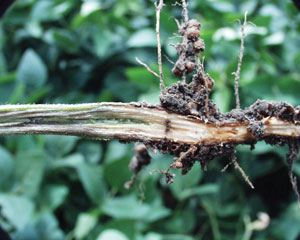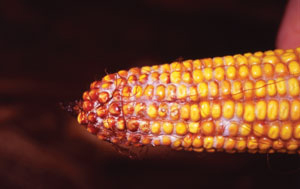
Features
Agronomy
Weeds
Manganese-glyphosate field trials seek to improve herbicide-nutrient reaction
Glyphosate and manganese have helped soybean growers boost their yields, but chemicals have a poor reputation for working together.
November 30, 2009 By Blair Andrews
Glyphosate and manganese have helped soybean growers boost their yields, but chemicals have a poor reputation for working together. A new product on the Canadian market, however, could change the way soybean farmers view that maligned relationship. Ontario crop advisors are taking a close look at Max-In Manganese NF 2.00 as a potential tank-mix option. It is a foliar product from Winfield Solutions LLC, and is distributed in Canada by the Agromart retail group.
 |
|
| In application tests done following soybean harvest, dandelion control was achieved in the test strips with the glyphosate, manganese and ammonium sulphate combination. | |
 |
|
| In the same field, an area that was missed with the ammonium sulphate application had a solid flush of dandelions the following spring. Advertisement
|
Farmers who believe their soybeans suffer from manganese deficiency have hesitated to add the micronutrient to the tank-mix, fearing it would antagonize the glyphosate. “You would start to lose weed control from the glyphosate because you don’t have as much glyphosate available and you’re going to tie up that manganese,” says Brandon Yott, product development and marketing manager for Agromart. “If you don’t use that tank-mix option right, you can lose both your glyphosate and nutrients.”
While the common recommendation is to spray manganese eight to 10 days after a glyphosate application, some growers think the extra pass is not worth the cost. Also, the weather conditions may prevent the manganese application even though farmers are willing to absorb the extra expense. “There are a lot of acres of beans out there that should be sprayed with manganese, but the guys just don’t want to make that second pass,” says John Waters, certified crop advisor with Lakeside Grain & Feed in Forest, Ontario.
In an effort to find a compromise, Waters and his Lakeside colleague Brian Hoven, have been running field tests on Max-In. It is a product developed with built-in adjuvants that uses a highly soluble micronutrient source, which helps ensure the movement of micronutrients into the plant from the leaf cuticle. The product’s literature says the Max-In nutrients mix easily with other crop nutrients and crop protection products, including glyphosate-based herbicides. “Adjuvants make the environment better for the chemistry to work and the more soluble something is, the less the plant has to work,” says Yott.
To determine if Max-In would reduce weed control under field conditions in Ontario, Waters and Hoven mixed it with Roundup WeatherMAX and sprayed the combination in strip trials in the fall of 2008. They targeted large, intensive dandelion infestations in separate fields in Forest and Oil Springs. “It is one of the harder weeds to kill in the fall. So if there’s going to be a problem, we figured it would show up,” says Waters, explaining the rationale for using dandelions to test the efficacy of the glyphosate with manganese.
Three combinations were tested and compared: glyphosate; the glyphosate-manganese mix; and a mixture of glyphosate, manganese and Crimson (an ammonium sulphate product). Ammonium sulphate is used to tie up the cations in hard water, thereby increasing the availability of glyphosate for the plant.
When they went back to check their fields in the spring, Waters and Hoven had different results. Hoven saw little or no difference, saying he did not see any dandelions in his test strips. He also saw one area of solid dandelions in a small stretch that did not receive an application where he drove too wide between the manganese and the Crimson tests. “I know there was weed pressure there. So I know it definitely worked; the manganese didn’t tie up the Roundup,” he says.
Although the Crimson did not seem to offer an extra benefit, Hoven says he would not remove it from the mix. He conducted his tests in early October following soybean harvest. Had he waited another three weeks, Hoven suspects the Crimson would have had a greater impact.
Yott concurs, saying research by Dr. Peter Sikkema of the University of Guelph, Ridgetown Campus, has shown that mixing an ammonium sulphate water conditioner at higher rates can help counteract the antagonism and the loss of weed control. “Crimson reduces the tie-up of glyphosate, manganese and other cations in the tank, ensuring the chemistry moves through the wax of the leaves on the dandelions, in this case, allowing them to take in the glyphosate better,’’ says Yott, who adds that the water conditioner is not a permanent solution to the problem. He says “it buys time” because the ammonium sulphate will eventually release the glyphosate, which will then bind with other cations.
It appears as though the colder conditions were a factor in the other test. Waters, who conducted his trial two weeks later and in colder temperatures, says there were discernible differences. “You could see every line,” notes Waters. He estimated that there was 75 percent weed control in the glyphosate-manganese strip; 85 to 90 per cent in the glyphosate-manganese-Crimson strip; and the strip sprayed with just glyphosate was clean.
Next steps
Testing the efficacy of WeatherMAX was just the first step of the assessment. Hoven and Waters would like to test more glyphosate products as well as analyze manganese performance during the growing season. “We’ve proven that the Roundup wasn’t tied up in a fall burn-down (in one trial). We’re now going to test it in-crop and see if we’re losing any manganese effectiveness,” says Hoven.
Hoven is planning to conduct more trials that will involve one strip with glyphosate, one with manganese and one with glyphosate plus manganese. He adds that the results could reveal some key benefits for soybean growers if the glyphosate-manganese combination works well. “We have quite a few guys in our area that are finding a yield kick from manganese. If we can find something that works, then it will really improve yields.”
The other potential benefit is the convenience of one application. While Yott says the second pass of spraying manganese a few days after the glyphosate application is still preferable, growers may have another choice. “We’re looking at an option for a grower to eliminate a pass if that is what his desire is. The big thing is that the guys can put it (manganese) on when the plant needs it, and while they’re putting their glyphosate on already,” says Yott. “And if they can’t get that separate pass, for whatever reason, we have an option for them where they can still get some of the value of the manganese in their crop without compromising the performance of their glyphosate.”